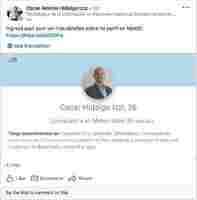Use this 4-step method to block unwanted thoughts and improve focus

The best way to manage your inbox is to send fewer emails
Is your email inbox taking over your work-life? Are you unable to get any “real” work done because you’re too busy responding to emails? Do you feel stressed, distracted, and overwhelmed when you see new emails pop up in your email inbox? You’re not alone. The average office-dwelling professional received 100 messages per day.

Your email inbox is a perfect distraction
Researchers have found that when people are interrupted during a task, by checking email, for instance, they tend to subsequently make up for the lost time by working faster. However, this comes at a cost — higher levels of stress and frustration. The more we respond to external triggers like an email, the more we train our brain in a neverending stimulus-response loop. We condition ourselves to respond instantly. Soon, it feels impossible to do what we’ve planned because we’re constantly reacting to external triggers instead of attending to what’s in front of us.
Perhaps the answer is to simply ignore the external trigger — ignore the email notification. Maybe if we don’t act on the notification then we can go about our business and quickly silence the interruption when it happens. Not so fast. A study published in the Journal of Experimental Psychology: Human Perception and Performance, found that receiving a cell phone notification but not replying to it was just as distracting as responding to a message or call.
Email is perhaps the mother of all habit-forming products. For one thing, it provides a variable reward. As the psychologist B.F. Skinner famously discovered, pigeons pecked at levers more often when given a reward on a variable schedule of reinforcement. Similarly, the email’s uncertainty keeps us checking and pecking. All of that uncertainty provides a powerful draw to see what we might find when we next open our email inbox.
Reduce your email communication
So, what’s the solution? Here is a way to get some relief from our constantly pinging inbox. As with many things in life that take more time and attention than we’d like, we can get our email inbox under full control. There are techniques we can deploy as part of our working routines to defuse the unhealthy magnetism of unread emails.
In order to reduce the total amount of time we spend on emails per day, we need to reduce the total number of messages received. To receive less email, we must send fewer emails.
Most of the emails we send and receive are not urgent. Yet, our brain’s weakness for variable rewards makes us treat every message in our email inbox as if it’s time-sensitive. That tendency conditions us to check constantly, return replies, and bark out whatever requests come to mind instantaneously. These are all mistakes.
You’d be amazed by how many things become irrelevant when we give them a little time to breathe. By asking the other party to wait a bit, we’ve given them the chance to come up with an answer for themselves — or, as is often the case, time for the problem to just disappear under the weight of some other priority.
Email inbox management: choose quality over quantity
In my case, I receive dozens of emails per day asking to discuss something related to my books. I love talking with my readers, but if I responded to each email, I wouldn’t have time for anything else. Instead, to reduce the number of emails I send and receive, I schedule “office hours.” Readers can book a fifteen-minute time slot with me on my website.
Scheduling office hours helps reduce the number of back-and-forth emails. The practice works for just about anyone who struggles with an overflowing email inbox. You are setting aside time now for the person in front of you so that you have fewer emails bouncing around later. While not every emailed question can wait for a weekly office hour, a significant number of messages are not as urgent as we first think and are better handled in person.
You may be thinking to yourself, maybe office hours can be useful, but emails are still really important. They’re likely much less important than you think. Researchers wrote in Harvard Business Review, “We estimate that 25 percent of that time is consumed reading emails that should not have been sent…and 25 percent is spent responding to emails that…should never have [been] answered.” In other words, about half of the time we spend on email is as productive as counting cracks in the ceiling.
Of course, email can still be a useful tool. But there are many situations where email hurts rather than helps. In the case of complex matters where tone and nuance are important, scheduling regular office hours can lead to better communication and fewer emails.
So the next time you receive a non-urgent question over email, try replying with something like, “I’ve held some time on Tuesdays and Thursdays from 4:00 to 5:00 If this is still a concern then, please stop by or schedule a meeting to discuss this further.” You can even set up an online schedule tool to let people book a timeslot.
If you’re still skeptical, try out this office hour technique for a week or two to see if it helps alleviate some of the emails you’re sending and receiving. After you test this out, leave a comment below and let me know how office hours have helped save you from your email inbox.
By proactively making time in your day for people to discuss important issues that would otherwise clog your email inbox, you’ll spend less time emailing and more time being indistractable.
This article was originally published on Nirandfarom by Nir Eyal. You can read the original article here .
Growth hacking isn’t just a buzzword — let these 20K+ new users be your inspiration
‘Growth hacking‘ has come to take on a not so positive meaning. Many see it as a hyped-up buzzword that indicates a cheap temporary solution — but I couldn’t disagree more. What it’s really about is finding small and effective actions you can execute with the resources you’ve already got.

So to drive you to start looking for the opportunities that are already present at your own startup, I’d like to give you a full rundown of a recent growth hacking process my team did.
Now let’s start by setting the scene the almost all of us are familiar with:
Back in the days where traditional software engineering models were popular — before agile became the ruling and dominant mindset that almost every company shares — the relationship between a developer and a client was one where the client would give the developer a bunch of requirements (negotiated at the start), and the developer dutifully carried them out one by one.
This led to a ton of problems that you’ve probably heard of before (unable to respond to changing requirements, less user involvement in the process, large time gap between writing requirements and delivery, etc.).
Collaboration between developers and clients
In modern software engineering, we software development firms try to work alongside the clients from the bottom up, and in every phase of the project. The immediately apparent consequence of this is that the now continuous process of requirement specification becomes collaborative, and better decisions tend to be made because the client and the technical team are aligned.
Less obvious is the fact that when the developer is so intimately involved in all aspects of a project, the situation becomes a fertile land for the growth of innovative ideas.
If the development firm is encouraged to give insight pertaining to domains that are not exclusively related to the development cycle — such as Marketing, R&D, Human Resources, Production, etc. — they might come up with strategies or solutions that arise from a very different, more tech-oriented perspective. They might end up having an enormous impact, or even be the key to the project’s ultimate success.
The startup
Here at Light-it, we’ve recently had one of these wonderful moments where our marketing team had an idea that ended up delivering tremendous value to one of our clients.
The client in question was job-search startup MjobO. The MjobO platform works in the following manner:
Talented individuals in search of a job upload their resumé to the platform.
Businesses upload job offers to the platform, with a focus on transparency; they need to specify the starting salary, the working hours, and job responsibilities.
Based on a position’s required qualifications, each job offer gets matched with the potential applicants.
We built their platform here at Light-it. In keeping with the philosophy I wrote about in the first section, as we worked on the project, we sought to learn as much as possible about the entire MjobO enterprise.
The reasoning behind this was that valuable insights only arise when a team fully grasps a project in its complete length and breadth. It needs to understand every area of a project; hyper-focusing on development would make it hard to come up with insights that involve other areas of the project.
The eureka moment
The eureka moment came as the development team was working on the functionality to upload resumés . When a job searcher fills out the form with all of their qualifications, MjobO automatically generates a consistent, clean looking resum é. Businesses use these to determine the best applicant for the job.
While this functionality was being implemented, the marketing team pitched another use for these generated resumés . The thinking was that applicants might — after filling out and generating a clean looking resumé — want to share it elsewhere other than on MjobO. If it were possible to harness this impulse, an opportunity for viral marketing could arise.
So here’s what we did. In the screen shown after an applicant’s resum é is generated, the developers added a big, eye-catching button that reads “Share on LinkedIn.”
Most applicants are very eager to share their newfangled, updated resum é on their LinkedIn feed. So they do. It looks like this.


The shared post starts off by mentioning that the resum é comes from MjobO. As you can see, the LinkedIn feed only shows a small snippet of the resum é, and you need to click to see the full version. If you do click, you get redirected to the MjobO website.
This simple idea was massively successful. People who are browsing their LinkedIn feed are almost invariably either people who are looking for a new job, or people that are looking to hire new employees.
In either case, these people are instantly interested when they find out about MjobO, a job-search platform. That’s why, upon seeing the shared resum é on their feed, LinkedIn users usually click on the snippet and do end up learning more about MjobO.
Growth hacking
So what were the results in terms of new users? That’s our metric of success. And fortunately, in this case, they were staggering.
Out of 22,000 applicants, 2,500 shared their resumé on LinkedIn. We were able to see in real-time how all the shared posts in LinkedIn were driving traffic towards the MjobO website, and how that new traffic reliably converted into new applicants. This was a viral cycle, because new applicants would then create their own resum és and would share them themselves, which allowed the platform to grow exponentially.
After all was said and done, in just one week after launch , MjobO gained over 20 THOUSAND NEW USERS. This was massive for a new company in a niche market.
The whole affair was an example of the technique referred to as ‘g rowth hacking .’ This term is an umbrella term for strategies focused solely on growth. These are usually used by startups such as MjobO, which during their early stages don’t have giant marketing budgets. The basic gist of growth hacking is figuring out creative, low-cost strategies to generate as much growth as possible, without spending a lot of money.
That’s precisely what we achieved with MjobO. Without spending a dime, we were able to take advantage of LinkedIn’s scale in order to reach people that fit exactly with MjobO’s target demographic (i people looking for jobs or people looking for employees). And we managed to do that by being creative and thinking in terms of what drives MjobO’s growth, and how we could optimize it.
AirBnb took advantage of CraigList’s scale. They started to automatically post their listings on CraigList, allowing them to reach a lot more users than they initially had, and redirecting them to their website.
Hotmail appended a line at the end of each e-mail encouraging people to sign-up.
DropBox used to offer more storage space to people who referred other users to the website.
Get started
The purpose of this post is to inspire you to get started with growth hacking yourself. Start thinking exclusively in terms of growth: what creative way can you think of to grow your product or service in an unexpected way?
I advise you to write down any strategies you can come up with, and start trying them out; you never know which one could actually stick. The key part is to always focus on strategies that allow you to have a measurable understanding of how much growth they are actually driving. Metrics are our bread and butter, use them wisely.
It might also be useful to read more about the subject, and about past examples of successful strategies. I recommend The Definitive Guide to Growth Hacking as a very comprehensive resource.
Now go make it happen!